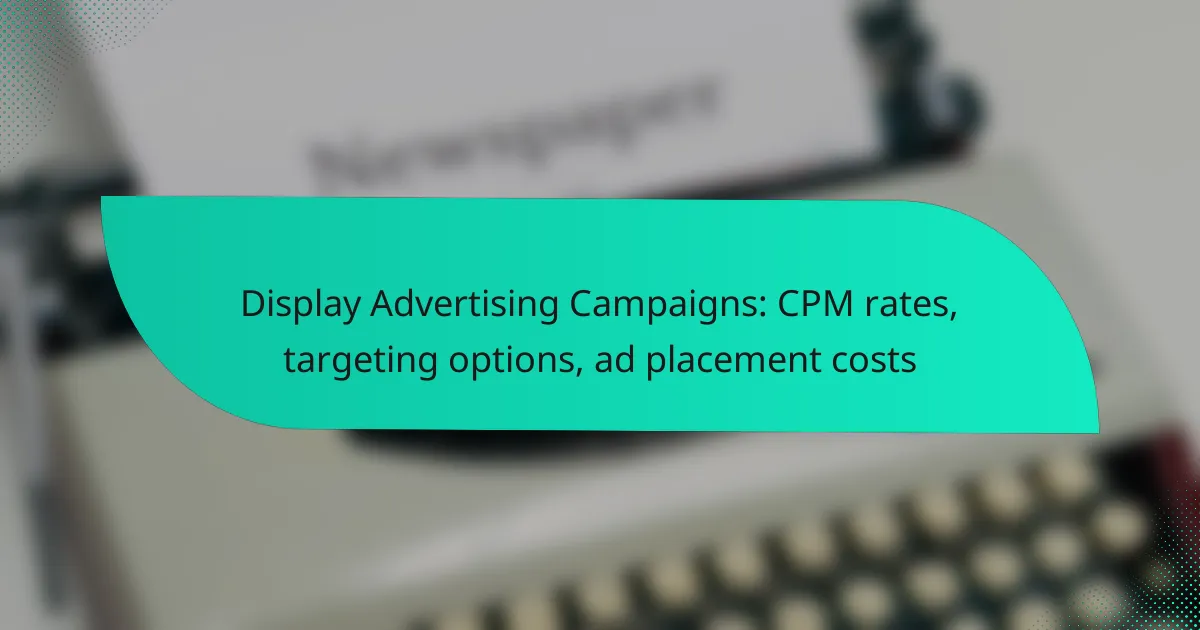Display advertising campaigns are an essential tool for reaching targeted audiences, with CPM rates in the UK typically ranging from £1 to £10. Advertisers can enhance their effectiveness by utilizing various targeting options, such as demographic and behavioral targeting, while also considering the fluctuating costs associated with ad placements. Understanding these elements is key to optimizing budgets and maximizing the impact of advertising efforts.

What are the CPM rates for display advertising in the UK?
CPM rates for display advertising in the UK typically range from £1 to £10, depending on various factors such as targeting options and ad placements. Advertisers should consider these rates when planning their campaigns to ensure effective budget allocation.
Average CPM rates
The average CPM rates in the UK can vary significantly based on the platform and audience targeting. Generally, rates tend to be lower on broader networks and higher on premium sites. For example, a standard display ad might cost around £2 to £5 CPM, while ads on niche or high-traffic sites could reach £10 or more.
Seasonality also plays a role; during peak advertising periods, such as the holiday season, CPM rates may increase due to higher competition for ad space.
Factors affecting CPM rates
Several factors influence CPM rates in display advertising, including audience demographics, geographic targeting, and the ad format used. Targeting specific demographics, such as age or interests, often results in higher CPMs due to the increased value of reaching a more relevant audience.
Additionally, the placement of the ad can impact costs. Ads placed in prominent positions, such as above the fold or on popular websites, typically command higher rates compared to less visible placements. Advertisers should weigh these factors to optimize their campaign performance and budget.

What targeting options are available for display advertising?
Display advertising offers various targeting options to reach specific audiences effectively. These options include demographic targeting, which focuses on characteristics like age and gender, and behavioral targeting, which considers users’ online behaviors and interests.
Demographic targeting
Demographic targeting allows advertisers to reach audiences based on specific characteristics such as age, gender, income level, and education. This method is particularly useful for brands that have a clear understanding of their ideal customer profile.
For example, a luxury car brand may target individuals aged 30-55 with high income levels, while a children’s toy company might focus on parents aged 25-40. Advertisers can refine their campaigns by selecting multiple demographic criteria to ensure their ads reach the most relevant audience.
Behavioral targeting
Behavioral targeting involves analyzing users’ online activities, such as websites visited, search queries, and previous interactions with ads. This approach enables advertisers to serve ads to users who have shown interest in similar products or services.
For instance, if a user frequently visits travel websites, they may see ads for vacation packages or travel gear. This method can significantly increase engagement rates, as the ads are more relevant to the user’s current interests and needs.

How do ad placement costs vary in the UK?
Ad placement costs in the UK can fluctuate significantly based on various factors, including the platform used, the ad format selected, and the specific targeting options chosen. Understanding these variables is crucial for optimizing your advertising budget and maximizing campaign effectiveness.
Cost by platform
The cost of ad placements varies widely across different platforms. For instance, social media platforms like Facebook and Instagram typically charge lower CPM rates compared to search engines like Google, where competition can drive costs higher. On average, CPM rates on social media can range from £5 to £15, while Google Ads may see rates from £10 to £30.
When selecting a platform, consider your target audience and where they are most active. For example, if your audience skews younger, platforms like TikTok or Snapchat might offer more cost-effective placements. Always evaluate the return on investment (ROI) for each platform to ensure you’re spending wisely.
Cost by ad format
Different ad formats come with varying costs, which can impact your overall campaign budget. Display ads, for example, generally have lower CPM rates compared to video ads, which can be more engaging but also more expensive. Display ads might cost around £5 to £15 per thousand impressions, while video ads can range from £15 to £50.
When choosing an ad format, consider the goals of your campaign. If brand awareness is your primary objective, investing in video ads may yield better engagement despite the higher costs. Conversely, for direct response campaigns, display ads may provide a more cost-effective solution. Always test different formats to find the best fit for your audience and objectives.

What are the best practices for display advertising campaigns?
The best practices for display advertising campaigns focus on effective targeting, creative design, and strategic placement. Implementing these practices can significantly enhance engagement and conversion rates while optimizing costs.
Creative design tips
Effective creative design is crucial for capturing attention in display advertising. Use bold colors, clear imagery, and concise messaging to ensure your ads stand out. Aim for a clean layout that guides the viewer’s eye towards the call to action.
Consider A/B testing different designs to identify which elements resonate best with your audience. For instance, varying the size of the text or the placement of images can yield insights into what drives higher engagement.
Effective call-to-action strategies
A strong call to action (CTA) is essential for driving conversions in display advertising. Use action-oriented language that clearly tells viewers what to do next, such as “Shop Now” or “Learn More.” Position your CTA prominently within the ad to ensure it is easily visible.
Incorporate urgency or exclusivity in your CTAs to encourage immediate action. Phrases like “Limited Time Offer” or “Exclusive Deal” can create a sense of urgency that prompts users to click. Test different CTAs to find the most effective wording for your target audience.

How can I measure the success of my display advertising campaigns?
To measure the success of display advertising campaigns, focus on key performance indicators (KPIs) that reflect engagement and conversion. Metrics such as click-through rates (CTR), conversion rates, and return on ad spend (ROAS) provide insight into campaign effectiveness.
Key performance indicators (KPIs)
Key performance indicators (KPIs) are essential for evaluating the effectiveness of your display advertising campaigns. Common KPIs include click-through rate (CTR), which measures the percentage of users who click on your ad, and conversion rate, indicating how many of those clicks result in desired actions, such as purchases or sign-ups.
Another important metric is return on ad spend (ROAS), which calculates the revenue generated for every dollar spent on advertising. A ROAS of at least 4:1 is often considered a good benchmark, but this can vary by industry.
Tools for tracking performance
Several tools can help track the performance of your display advertising campaigns. Google Analytics is widely used for monitoring traffic and conversions, allowing you to attribute results directly to your ad campaigns. Additionally, platforms like Facebook Ads Manager provide in-depth analytics for social display ads.
Consider using specialized software like AdEspresso or SEMrush for more detailed insights and optimization suggestions. These tools can help you analyze data trends, adjust targeting, and improve overall campaign performance.

What are the emerging trends in display advertising?
Emerging trends in display advertising focus on enhancing effectiveness through technology and personalization. Advertisers are increasingly leveraging programmatic solutions and advanced targeting options to optimize their campaigns and improve engagement rates.
Programmatic advertising growth
Programmatic advertising is rapidly expanding, automating the buying and selling of ad space in real-time. This method allows advertisers to target specific audiences based on data analytics, leading to more efficient ad placements and potentially lower costs.
As programmatic advertising continues to grow, it is essential to understand the various platforms available, such as Google Ads and Facebook Ads. These platforms offer different pricing models, including CPM (cost per thousand impressions) and CPC (cost per click), which can significantly impact your budget and campaign performance.
Personalization advancements
Personalization in display advertising is becoming increasingly sophisticated, allowing brands to tailor their messages to individual users. By utilizing data such as browsing history and demographic information, advertisers can create highly targeted ads that resonate with their audience.
To effectively implement personalization, consider using dynamic creative optimization (DCO) tools that adjust ad content in real-time based on user behavior. This approach can enhance user engagement and improve conversion rates, making it a valuable strategy for modern display advertising campaigns.
